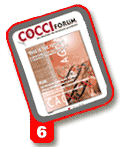Special Report: Talking Turkey
Veterinarians, nutritionists and live-production managers flock to Missouri for the lowdown on new approaches to coccidiosis management in growing poults
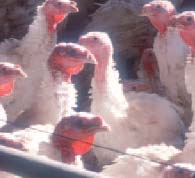 |
It's no secret that coccidiosis is a
potentially serious problem for the
world poultry industry. But while
the world turkey market may be smaller
in numbers, the disease and, to some
extent, current management programs,
have even greater potential to shortchange
producers on performance and
profits
Here's why:
First, the cycle for growing turkeys
is considerably longer than for other
commercial fowl. So turkeys have a
longer period of potential exposure to
coccidiosis as well as other disease
organisms. And any factor "whether it
be disease or some other problem -
that impedes a bird's uptake of nutrients
is likely to have a negative impact
on the bottom line
Fortunately, much progress has
been made recently in controlling coccidiosis
in turkeys. A recent Cocci-
Forum conference of turkey producers
held in Branson, Mo., "New Strategies
for Coccidiosis Management," brought
together representatives from growers
representing 79 million birds, or onethird
of the total US production.
Coccidiosis: Reviewing the basics
Dr. John Radu, a technical service veterinarian
for Schering-Plough Animal
Health, kicked off the conference with
a review of coccidiosis-management
basics. His presentation included a general
overview of coccidiosis in turkeys
and the protozoan parasite Eimeria that
causes the disease.
Seven species of Eimeria are present
in turkeys, he explained, but only four
are pathogenic. Those are E. adenoides,
E. gallapavonis, E. meleagrimitis and E.
dispersa.
The main source of Eimeria infection
is from birds actively shedding
oocysts of Eimeria in their feces.
Oocysts are essentially the developing
eggs of the Eimeria coccidia. Infection
in the flock spreads as other birds peck
in the litter or consume feed or water
that's been contaminated by the coccidia.
"It's extremely difficult to estimate
the total impact of Eimeria infections,"
Radu told attendees. "That's because
Eimeria tends to have very complex
interactions with other organisms."
Radu also said a variety of other factors
such as seasonal variations in temperature
and humidity (litter moisture),
are particularly important. Outbreaks of
coccidiosis in turkeys occur most often
during colder, wetter months of the
year, usually the spring and fall, but
can occur at any time.
Older birds also at risk
Another point emphasized by Radu
was that, contrary to popular belief,
coccidiosis can have
a negative impact on
all phases of the
growing cycle. It's
not just a disease of
young poults 3 to 10
weeks old. True, the
peak of oocyst shedding
usually occurs
in turkeys between
days 35 and 50. But,
he says, several trials
have shown that
variable patterns of
oocyst shedding take
place much later,
sometimes as late as
20 weeks.
In practical terms, it's nearly impossible
to entirely eradicate coccidia from
the growing environment. That being
the case, most strategies for dealing
with coccidiosis are aimed at maximizing
control and, more importantly, minimizing
losses.
One of the primary ways growers
try to control coccidiosis is by the use
of anticoccidials, either ionophores or
synthetically manufactured chemical
drugs.
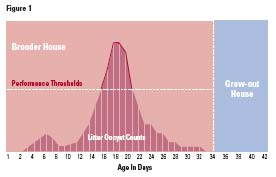 |
Two ionophores are currently
approved for use in turkeys: monensin
and lasalocid. The chemical anticoccidials
available for use are: halofuginone,
zoalene, amprolium, and diclazuril.
"Unfortunately," says Radu, "no
ideal or perfect in-feed anticoccidial -
either ionophore or chemical "has yet
been developed.
"Every drug that's available has
drawbacks," he added. "In most cases
the overuse of anticoccidials will eventually
lead to development of organisms
with decreased sensitivity to the
drug. In other cases, the use of some
anticoccidial drugs may be associated
with a high level of toxicity, especially
if they're used repeatedly."
Anticoccidials: The downside
The chief drawback of in-feed anticoccidials is that Eimeria organisms tend to develop resistance to them over time. To cut down on the development of resistance, turkey producers have tended to rely on switching or rotating infeed anticoccidials annually.Still, there's evidence to indicate some of the anticoccidial drugs work better than others. One of the presentations at the Branson conference focused on results obtained with diclazuril (Clinacox), a new-generation, synthetic anticoccidial recently approved by FDA for use in turkeys.
Dr. Lanny Howell, Bella Vista, Ark., another technical service veterinarian for Schering-Plough Animal Health, reviewed results from 19 separate trials that were conducted with diclazuril in two locations.
In those studies, 2-week-old poults, infected with coccidiosis, were placed in battery cages and fed diets containing various concentrations of diclazuril. Researchers found that birds fed diclazuril showed consistent weight gains, lower fecal counts of coccidia, and reduced mortality due to coccidiosis, than did matched infected but nonmedicated controls.
Howell said researchers obtained optimal efficacy even at doses as low as 1.0 ppm.
Floor pen studies confirm efficacy
Similar results have been obtained in
floor pen studies. In two trials, conducted
in simulated commercial conditions,
investigators assessed the efficacy
of 1.0 ppm against mixed Eimeria
species in turkeys infected with coccidia
at 14 or 21 days of age.
As in the battery-cage studies, investigators
concluded that fecal scores for
coccidia in diclazuril-treated birds were
statistically lower than in controls.
Weight gains were improved in the
medicated birds and mortality was significantly
lower as well.
Results obtained in the floor pen
and battery-cage studies have also been
confirmed in field studies. At the
Branson conference, Howell said even
large doses of diclazuril "up to 10
ppm fed for 18 weeks "didn't produce
any negative clinical signs in
birds. That included indices of overall
clinical signs, measurements of body
weight, feed conversion, hematology,
and histology.
Toxicity to non-target animals or
environmental toxicity can sometimes
be an issue with various types of anticoccidials,
especially chemicals. However,
Howell reported that neither of
those problems appeared to be associated
with this new-generation anticoccidial,
diclazuril (Clinacox).
Studies in which various non-target
animals "ducks, horses, rabbits, dogs,
cattle "were experimentally fed
diclazuril produced no adverse effects
in any of the species studied. Nor, said
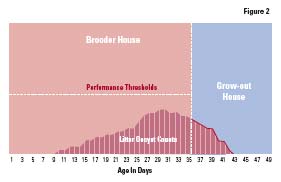 |
Dr. Howell, do studies show that
diclazuril will produce any adverse
environmental effects if it's released
into the environment under normal
poultry feed practices.
Vaccination: A refined strategy
Though vaccination against coccidiosis has been an available option for some time now and used extensively in breeders and layers, more and more turkey growers are adding vaccination to their strategies for controlling coccidiosis.At the Branson meeting, Dr. Rick Phillips, Pineville, La., worldwide director of technical services at Schering- Plough Animal Health, outlined the rationale behind vaccination and underscored some of the reasons many turkey producers are increasingly relying on that approach.
Like other vaccines used in turkey production, coccidial vaccines aim to build immunity "in this case, against all four of the pathogenic species of coccidia that infect turkeys.
Phillips explained how one vaccine, Coccivac®-T, works: Every dose of vaccine contains a predetermined number of live, susceptible, pathogenic species of coccidia. The vaccines are administered to poults at an early age, usually 1 to 3 days, via a spray cabinet in the hatchery. Once the vaccine has been sprayed onto the poults, preening and pecking results in ingestion of the vaccine and the immunity-building process begins. It takes about a week for the coccidial parasite to complete its first life cycle in the bird. Then the mature parasite is excreted in the feces of each bird, and subsequently picked up by other birds. The newly ingested organisms then go through another life cycle, again taking about a week to complete. Each cycle of the coccidia "again, essentially a controlled challenge with susceptible organisms "that the bird is exposed to builds immunity.
Meeting the coccidial challenge
Phillips explained that when poults in a
brooder house are challenged by field
strains of coccidia, without being treated
by either in-feed anticoccidials or
vaccines, levels of coccidia spiral
upward above the desirable performance
threshold resulting in clinical coccidiosis
(Figure 1).
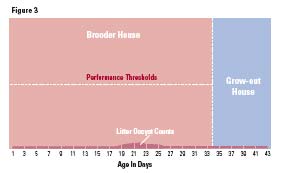 |
Though the disease is self-limiting
and is usually resolved by the time the
birds are moved to grow-out houses
around day 35, it nonetheless can take
a significant toll on overall health of the
birds and resultant growth rates.
"When ionophores are used to control
coccidiosis (Figure 2) the birds are
challenged by the cocci, but at a
reduced rate," Phillips explained.
Ionophores allow cocci to go through
cycling, and that helps build immunity.
But, Phillips points out, ionophores
slow down the process and levels of
cocci aren't always back down to riskfree
levels when the birds make their
move to the grow-out house.
"And those first few days in the
grow-out house are critical," Phillips
added. "It takes birds up to 2 weeks to
acclimate to the new environment and
to establish a new pecking order.
 |
During that time, their immune systems
are suppressed due to the increased
level of stress, and that may give the
cocci an opportunity to rebound."
Chemical anticoccidials produce still
another result (Figure 3).
"Effective chemical anticoccidials
clear the gut entirely of susceptible
organisms, and leave it open for
the less sensitive strains," Phillips
explained. "So if you use chemicals for
several cycles you'll see substantial
resistance developing by the third or
fourth time around."
Vaccines: The ideal option for turkeys
What about vaccines?
Phillips said they're ideal for use in
turkeys. One reason is that the growth
cycle in turkeys is considerably longer
than for other fowl.
"That gives them more time to catch
up on any growth they may have lost
due to the challenge of the vaccine,"
Phillips said. "You give the vaccine on
day one," says Phillips. "You then have
21 to 28 days to build immunity"
(Figure 4). You've given a controlled
dose, so the coccidial exposure is mild,
well below the performance threshold.
And by day 28 the cycling is complete."
The birds then have a week to fully
recover from the subclinical infection
before they're moved to the stressful
environment of the grow-out house.
Radu told producers about some of
the results obtained using Coccivac-T, a
live-oocyst coccidiosis vaccine especially
formulated for use in turkeys.
In one trial, results using Coccivac-T
were compared with those achieved
using lasalocid (Avatec), an ionophore
anticoccidial. About 300 poults were
involved in the study "half were
administered Coccivac-T, the other half
lasalocid.
Neither group of birds showed evidence
of clinical coccidiosis at any time
during the trial. However, Radu stated
that there was one important difference
between the two treatment groups -
performance.
"The Coccivac-T birds weighed significantly
more than the hens that
received Avatec (16.44 lbs compared
with 16.04 lbs, respectively)," he said.
Mortality in both groups of birds was
very low.
Coccivac-T versus monensin
In another trial, Coccivac-T was evaluated
in comparison with monensin
(Coban). More than 1,100 birds were in
each treatment group. One treatment
group was vaccinated with Coccivac-T
at the hatchery via spray cabinet application.
The other treatment group
received monensin in the feed continuously
for 12 weeks. After 12 weeks, the
monensin was discontinued and both
treatment groups were put on a regimen
of virginiamycin for the remaining
6 weeks.
"At the conclusion of the 18-week
study," Radu told attendees, "both
groups had performed well and there
was no statistically significant difference
in performance between the
groups."
One important advantage of vaccination,
Radu said, is that it can be used
continuously in flock after flock or in a
rotation program with anticoccidials.
"When used in a rotation program it
has the benefit of seeding down the litter
with highly sensitive oocysts," he
added. "And that's a big plus. It results
in dilution or displacement of any
resistant strains that may be present.
When the switch is made to an in-feed
anticoccidial, it's likely to be more
effective."
Three Weapons for Battling Coccidiosis in Turkeys
Schering-Plough Animal Health has developed three key products that are
specifically targeted toward keeping turkeys healthy, from the hatchery to
the processor. |
Source: CocciForum Issue No.6, Schering-Plough Animal Health.







